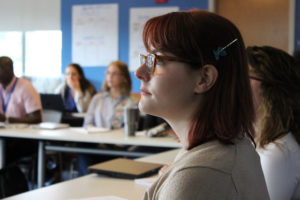By Lauren Javins
For three intensive weeks, I was a participant of the International Peace and Security Institute’s (IPSI) symposium on the new frontiers in peacebuilding. IPSI connected thought-leaders to members of civil society who worked in conflict areas, wanted to broaden their knowledge of the peacebuilding field, and gain in-depth training in conflict diagnosis tools and methods to use in their respective countries.

At the symposium, I was struck by the breadth of knowledge each participant possessed on different aspects of the conflict spectrum. We had participants versed in access to justice, humanitarian aid and refugee resettlement, and those who have had dialogues with armed groups. All of these people wanted to take the skills learned at the IPSI symposium back to their communities.
As a recent graduate of a masters program in conflict resolution, and as an American, I found that there was a discrepancy in where I would practice conflict resolution. Though I got my degree from an American University, there was always an implicit acknowledgement among my colleagues that we would work abroad. Conversations on conflict diagnosis and management always used international case studies – always focused on conflict outside of the United States.
But the IPSI symposium made me realize that I want to try and apply my skills to conflict here, in my home. We are in a period of transition, identity crisis, and severe economic disparity and racial discrimination. The US is coming to terms with its history – and it would be negligent as a conflict resolution practitioner and as an IPSI student to not use my skills here.
Interestingly enough, an internationally renowned mediator, Joyce Neu, who spoke to us on mediation, said the same thing. She mentioned that she wanted to now focus her practice in the United States, but felt at a loss as to where to start. Perhaps this is why our studies focused outwardly – the more personal a conflict, the harder it is to resolve.
Reflecting on your country’s problems necessarily means turning inwards and analyzing yourself as well. Turning the mirror on oneself is perhaps the hardest part of peacebuilding, but probably the most important.
As Thomis Kempis most aptly says, “first keep the peace within yourself, then you can also bring peace to others.” I believe that to bring peace to the world, we have the start inside ourselves – practice peacebuilding within ourselves, our communities, and our countries – to create a nuanced, yet global perspective on what peace means for humanity.
As difficult as self-reflection can be, building peace will always be a constant struggle. It will never be so easy as to change the way you think, let alone your community or your country. But the struggle to find inner peace is synonymous with finding peace for your country or others.
To build peace, we must fist allow ourselves to reflect on who we are, with empathy, to understand ourselves, our societies, and, therefore, our conflicts.

